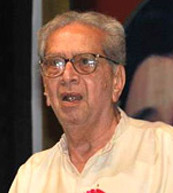


Despite his near-eighty age, Dr.Shriram Lagoo still retains that trademark penetrating gaze. His bespectacled brown eyes try to size me up and upon knowing my Marathi roots, they immediately brighten up. The veteran actor- coming to Dubai for the first time to perform in a Marathi play- Mitra, organized by Pratibimb, immediately agrees for an interview. We settle in his hotel room and soon, the septuagenarian is lost into memories of his long, illustrious career.
The thespian who in the 1970s and 80s, gave us many soul-stirring performances in Marathi plays like Nata Samrat and Himalayachi Saavli; Marathi films like Pinjara and Saamna and Hindi films like Gharonda and Lawaris, talks in beautiful Marathi- giving off that typically original Poona-based Puneri flavour. His reminiscences tell a story of a successful doctor who went on to become an actor to reckon with. Here are the excerpts- all in his own words:
The Foundation:
“My school- Bhave School in Pune had a great tradition in dramatics. There I was made to act in a school play at a very young age but I was so scared that I messed it up. I had practically decided there and then that never would I dare to act on stage again. Still I kept on watching a lot of Marathi plays and was fascinated by great actors like Nanasaheb Phatak, Keshavrao Daate, Mama Pendse and Master Dinanath. Later in High School, I started appreciating acting of Hollywood legends like Paul Muni, Spencer Tracy, Laurence Olivier, Greta Garbo, Norma Shearer and Ingrid Bergman. At that stage, fascination for acting was there but still that stage- fear lurked in mind.”
Medicine or Acting?
“Only when I entered medical college, did I try my hand at acting again. In those five years, I did five major plays and ten-odd one-act plays. The appreciation, the applause all got to me. Now acting became my first love. Later I did a post-graduation in ENT and started my medical practice. Since my father was an established doctor and since I also had good surgical skills, I soon settled into a flourishing practice. With like-minded drama- lovers, I helped establish Progressive Dramatics Association to keep my acting doors open. Juggling with two careers was proving difficult and I had to take a final decision. A three year stint in Africa, where I couldn’t do drama was the final straw that tilted the balance and on return to India, I said good-bye to medicine and became a full-time actor. I was forty-two and the year was 1969.”
Nata Samrat – The Emperor of Acting
“My first eight professional plays flopped badly but my acting was appreciated. All I was waiting for was an ideal break. Then came Nata Samrat, a touching family drama about a retired legendary actor. It was an extremely demanding role- both physically as well as emotionally. It got rave reviews, even the noted playwright V.V. Shirwadkar himself wrote- ‘It is rare to see an actor portraying a role exactly as envisioned by the author. I have been fortunate to see such a performance.”
“Around the same time, my other performances like Kaachecha Chandra and Gidhade became popular and I was thrust into limelight. Later I got equally challenging roles like Himalayachi Saavli, Udhwast Dharmashala and Socrates.”
Pinjra – his entry into films
“My success in drama brought me film offers and my first Marathi film- Pinjra became a superhit. Personally I don’t think that performance or that film was anything special. V.Shantaram – the great director of superb films like Maanus and Shejaari, was very disciplined and methodical but he was creatively finished by that time and later he tried to shoot Pinjra in Hindi as a frame- by- frame replica- an experiment that failed miserably.”
“In Hindi films, I realized quickly that I am bound to do roles of fathers and uncles, thanks to my late entry, my peculiar appearance and commercially dictated trends. Even though I did more than one hundred and fifty Hindi films, I just count a few films like Gharonda, Kinaara, Inkaar, Insaaf Ka Tarazu, Saajan Bina Suhagan, Ek Din Achanak and Ek Pal as memorable.”
Laawaris and Amitabh
“My role as a drunken driver and my confrontational scene with Amitabh in Laawaris are still remembered. I think Amitabh is a very talented actor but I feel later in his career, he became entrapped in his successful image. He did not really try to change that image. I still remember director Hrishikesh Mukherji’s distress when Amitabh made him introduce a needless fight scene in Jurmaana. It was just because their earlier emotional venture- Aalap had flopped and Amitabh did not want to take risk. Still if he is there at the top because he has that much caliber and discipline to sustain for this long a period.”
His Hobbies:
“I keep myself fit. I read a lot. Indian classical music of Kumar Gandharva, Kishori Aamonkar and Malini Rajurkar can keep me entranced for hours. In popular music, I like old songs of singers like Saigal, Noor Jehan, Kanan Bala and Pankaj Mullick. Acting still remains my passion and I will continue as far as I can go.”
His philosophy of acting:
“I studied and tried out acting methods of masters like Stanislovsky and Brekht but then I evolved my own style. I don’t believe in total involvement of the actor into a character. Actor has to remain distant and detached from the character but his technique should be such that audience should feel as if he is living the character.”
“Film-maker Shambhu Mitra once told me- ‘An actor should be an athlete and a philosopher.’ He further said, ‘An actor is an instrument and he is also the player of that instrument.’ I have always tried to put his advice into practice.”